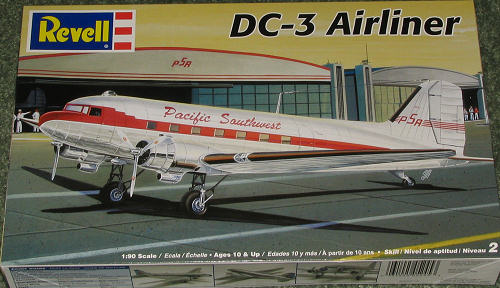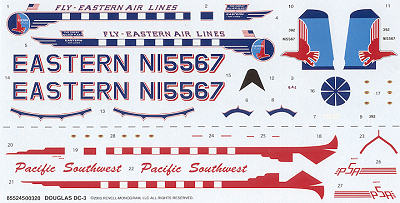
| KIT: | Revell 1/90 DC-3 |
| KIT #: | 85-5245 |
| PRICE: | $12.25 MSRP |
| DECALS: | Two options |
| REVIEWER: | Scott Van Aken |
| NOTES: | reboxed Monogram kit |

| HISTORY |
The Douglas DC-3, which made air travel popular and airline profits possible, is universally recognized as the greatest airplane of its time. Some would argue that it is the greatest of all time.
Design work began in 1934 at the insistence of C.R. Smith, president of American Airlines. Smith wanted two new planes -- a longer DC-2 that would carry more day passengers and another with railroad-type sleeping berths, to carry overnight passengers.
The first DC-3 built was the Douglas Skysleeper Transport, and it was the height of luxury. Fourteen plush seats in four main compartments could be folded in pairs to form seven berths, while seven more folded down from the cabin ceiling. The plane could accommodate 14 overnight passengers or 28 for shorter daytime flights. The first was delivered to American Airlines in June 1936, followed two months later by the first standard 21-passenger DC-3.
In November 1936, United Airlines, which had been a subsidiary of Boeing until 1934, became the second DC-3 customer. The DC-2 had proved more economical than the Model 247 and United assumed the DC-3 would continue that lead. Initial orders from American and United were soon followed by orders from more than 30 other airlines in the next two years.
The DC-3 was not only comfortable and reliable, it also made air transportation profitable. American's C.R. Smith said the DC-3 was the first airplane that could make money just by hauling passengers, without relying on government subsidies. As a result, by 1939, more than 90 percent of the nation's airline passengers were flying on DC-2s and DC-3s.
In addition to the 455 DC-3 commercial transports built for the airlines, 10,174 were produced as C-47 military transports during World War II. For both airline and military use, the DC-3 proved to be tough, flexible, and easy to operate and maintain. Its exploits during the war became the stuff of legend. Today, more than six decades after the last one was delivered, hundreds of DC-3s are still flying and still earning their keep by carrying passengers or cargo.
| THE KIT |
 Despite
having '2005, made in China' embossed on the inside of the wing and under the
wing center section (why does RM do that?), this is the old box scale
Monogram kit that first appeared sometime in the 1950s. Rivets and all, though
those are actually pretty accurate if you've been around a DC-3/C-47.
Despite
having '2005, made in China' embossed on the inside of the wing and under the
wing center section (why does RM do that?), this is the old box scale
Monogram kit that first appeared sometime in the 1950s. Rivets and all, though
those are actually pretty accurate if you've been around a DC-3/C-47.
The silver plastic now comes in three bags instead of
rattling around in a box and like the original, has generic toy-like wheels,
equally generic engines molded inside cowlings, no cockpit but two grinning
pilot figures holding wheels, and oodles of ejector pin marks. They are on the
underside of the stab, on the gear legs, antennas and a few other places. A
separate rear door/stair is provided so you can show off your empty, ejector pin
marked interior . The clear
passenger windows all have rectangular slits in them for some odd reason. You
also get an astrodome to plunk atop the fuselage. Generally, the kit moldings
have held up well, though you'll find the mold flash to be a bit thicker than
you are used to. I also found the usual small sink areas near alignment pins and
slots.
. The clear
passenger windows all have rectangular slits in them for some odd reason. You
also get an astrodome to plunk atop the fuselage. Generally, the kit moldings
have held up well, though you'll find the mold flash to be a bit thicker than
you are used to. I also found the usual small sink areas near alignment pins and
slots.
The kit instructions are really a bit overboard in terms of simplicity as there are not that many parts to the kit, yet you get 12 largely drawn construction steps, one of which the sole purpose is to show a piece of thread for the radio wire. Markings are provided for two planes. One is the box art aircraft from Pacific Southwest and the other for the Smithsonian's Easter Airlines aircraft. Decals seem to be quite well done and I think they'll work out great.
| CONCLUSIONS |
I'm really quite pleased to see that nowhere on the box is there 'License fee paid to Boeing' or other drivel caused by greedy lawyers. I also note that the word 'Douglas' is never used anywhere, only 'DC-3'. While off-scale kits like this are not going to be scarfed up by accuracy freaks, many will be sold to those who just want a pleasant building experience without having to put too much effort into it. It also makes into a DC-3 that won't take over your display shelf!
| REFERENCES |
www.boeing.com
November 2006
Thanks to the overt kindness and generosity of your editor for providing this preview kit.
If you would like your product reviewed fairly and quickly by a site that has over 325,000 visitors a month, please contact me or see other details in the Note to Contributors.